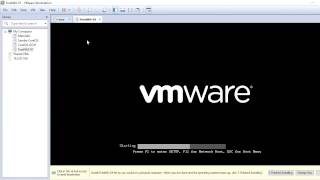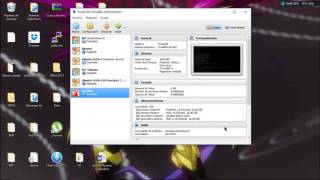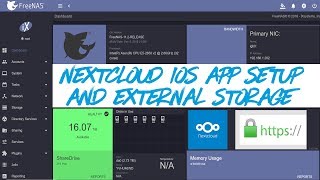Saturday, 10 January, 2026г.
















Где искать: по сайтам Запорожской области, статьи, видео ролики
пример: покупка автомобиля в Запорожье
FreeNAS 9.10 Storage Installation + Configuration + Overview on Oracle VirtualBox [2017]
This video tutorial shows FreeNAS 9.10 Storage Installation, Configuration and Overview on Oracle VirtualBox step by step. We also create and configure Storage Volume and setup Samba/SMB/CIFS share on FreeNAS storage. This tutorial is also helpful to installing FreeNAS 9.10 on physical computer hardware or bare-metal server.
Steps:
1- Create Virtual Machine on Oracle VirtualBox
2- Start FreeNAS 9.10 Storage Installation
3- FreeNAS Storage Initial Configuration
4- Create New User and Group on FreeNAS
5- Create Storage Volume
6- Create, Configure and Test NFS and CIFS/SMB Shares
7- FreeNAS 9.10 Storage Overview
FreeNAS 9.10 New Features and Improvements
FreeNAS 9.10 is based on FreeBSD 10.3, FreeNAS 9.10 combines hundreds of FreeBSD improvements with dozens of bug fixes and feature requests, while retaining the familiar user interface. Topping the list of FreeNAS 9.10 features are greater speed and scalability, dozens of new hardware drivers, USB 3.0 support, and the addition of the bhyve hypervisor.
Intel Skylake CPU and I219-V and I219-LM Gigabit Ethernet controller support stand out from a platform perspective and users can now use USB 3.0 storage and network controllers. FreeNAS plugin jails have been upgraded to FreeBSD 10.3 templates, which are binary compatible with existing jails. For the more adventuresome, FreeNAS 9.10 also includes FreeBSD’s bhyve hypervisor, opening the door to hosting virtual machines on FreeNAS with operating systems such as GNU/Linux and SmartOS.
FreeNAS Website: http://www.freenas.org/
FreeNAS 9.10 Minimum System Hardware Requirements
These specifications will suffice to get a small FreeNAS install running reliably with moderate performance for a few users.
- Multicore 64-bit processor (Intel strongly recommended)
- 8GB Boot Drive (USB Flash Drive suffices)
- 8GB RAM
- At least 1 direct attached disk (Hardware RAID strongly discouraged)
- One physical network port
FreeNAS no longer supports 32-bit hardware. The last FreeNAS Release with 32-bit hardware support was FreeNAS 9.2.1.9. This release also supported the UFS filesystem. Deployments on 32-bit hardware using UFS had lower hardware requirements of a 4GB boot device and 4GB of RAM. PLEASE NOTE that further security and stability updates to the 9.2.1.x branch are not guaranteed.
FreeNAS 9.10 Storage Recommended Minimum Hardware
These are the specifications for a hardy home media server or small office file share. At this point, your FreeNAS device will have the resources to run third party services and provide respectable performance.
- Multicore 64-bit processor
- 16GB Boot Drive (USB Flash Drive suffices)
- 16GB (ECC Recommended)
- At least 2 direct attached disks (Hardware RAID strongly discouraged). For best results, see FreeBSD Hardware Compatibility List for Supported Disk Controllers
- Drives designed for NAS (such as WD Red drives) are recommended.
- At least one physical network port (Intel Recommended). For best results, see FreeBSD Hardware Compatibility List for Supported Ethernet Chipsets
Hope you found it informative and useful. Any questions or comments are welcomed.
PLEASE SUBSCRIBE TO THE CHANNEL
----------------------------------------------------------------------------
Website: http://www.SysAdminsHowto.com/
Facebook Page: https://www.facebook.com/SysAdminsHowto/
Twitter: https://twitter.com/SysAdmHowto
Linux Video Tutorials: https://linux-video-tutorials.blogspot.com/
FreeNAS 9.10 Installation on VirtualBox Video: https://youtu.be/RLZdNqeKBCE
Теги:
freenas 9.10 installation virtualbox freenas 9.10 storage install freenas 9.10 virtualbox freenas 9.10 overview linux video tutorials freenas 9.10 installation configure freenas install freenas virtualbox configure freenas 9.10 freenas storage install freenas 9.10 free nas storage freenas 9.10 tutorial virtualbox freenas sysadmin freenas tutorial freenas setup storage install freenas freenas download free storage linux freenas 9.10 freenas 9.10 review
Похожие видео
Мой аккаунт


![FreeNAS 9.10 Storage Installation + Configuration + Overview on Oracle VirtualBox [2017]](https://pic.portall.zp.ua/mq/d/76/fNqeKBCE2RLZd6.jpg) У вашего броузера проблема в совместимости с HTML5
У вашего броузера проблема в совместимости с HTML5
![FreeNAS 11 Storage Installation + Configuration + Overview on Oracle VirtualBox [2017]](/images/mq/d/64/1oKsZtqU9y3gJ0.jpg)

